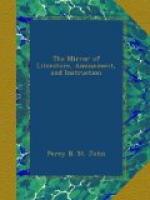Sir Abraham Hume, the accomplished annotator of the Life and Works of Titian, observes: “It appears to be generally understood that Titian had, in the different periods of life, three distinct manners of painting; the first hard and dry, resembling his master, Giovanni Bellino; the second, acquired from studying the works of Giorgione, was more bold, round, rich in colour, and exquisitely wrought up; the third was the result of his matured taste and judgment, and properly speaking, may be termed his own; in which he introduced more cool tints into the shadows and flesh, approaching nearer to nature than the universal glow of Giorgione.” After stating what little is known of the mechanical means employed by Titian in the colouring of his pictures, Sir Abraham observes: “Titian’s grand secret of all, appears to have consisted in the unremitting exercise of application, patience, and perseverance, joined to an enthusiastic attachment to his art: his custom was to employ considerable time in finishing his pictures, working on them repeatedly, till he brought them to perfection; and his maxim was, that whatever was done in a hurry, could not be well done.” In manners and character, as well as talent, Titian may not inappropriately be associated with “the most eminent painter this country ever produced”—Sir Joshua Reynolds.
* * * * *
HOSPITAL OF ST. CROSS, HANTS.
[Illustration: (The Church.)]
This is one of the most interesting structures in Great Britain. It stands about one mile west from Winchester, on the banks of the river Itchin. Its architectural character is of the first importance in illustrating the superior skill of our ancestors; while it has retained more of its original character than any similar record of ancient piety and charity in our island. Dr. Milner, in allusion to its principal features, observes: “the lofty tower, with the grated door, and porter’s lodge beneath it; the retired ambulatory; the separate cells; the common refectory; the venerable church; the black flowing dress and the silver cross worn by the members; the conventual appellation of brother, with which they salute each other; in short, the silence, the order, and the neatness, that here reign, seem to recall the idea of a monastery to those who have seen one, and will give no imperfect idea of such an establishment to those who have not had that advantage."[3]
St. Cross, however, “never was a monastery, but only an hospital for the support of ancient and infirm men, living together in a regular and devout manner.” The original founder was Henry de Blois, bishop of Winchester, who instituted it, between the years 1132 and 1136; and required that “thirteen poor men, so decayed and past their strength that without charitable assistance they cannot maintain themselves, shall abide continually in the hospital, who shall be provided with proper clothing




